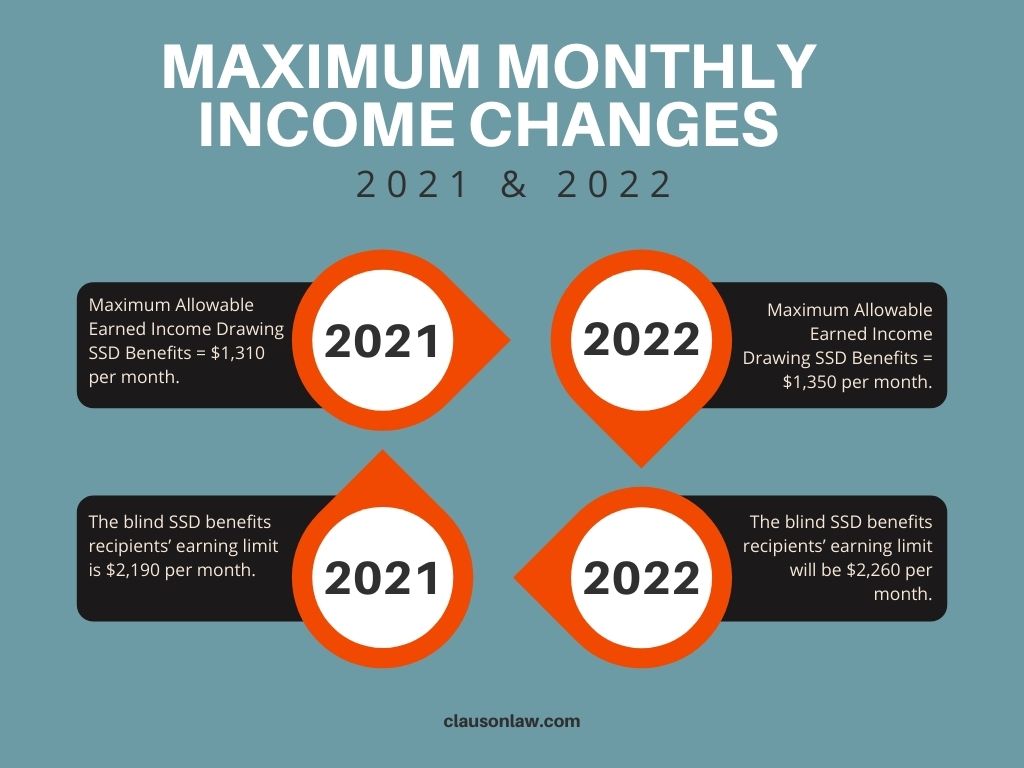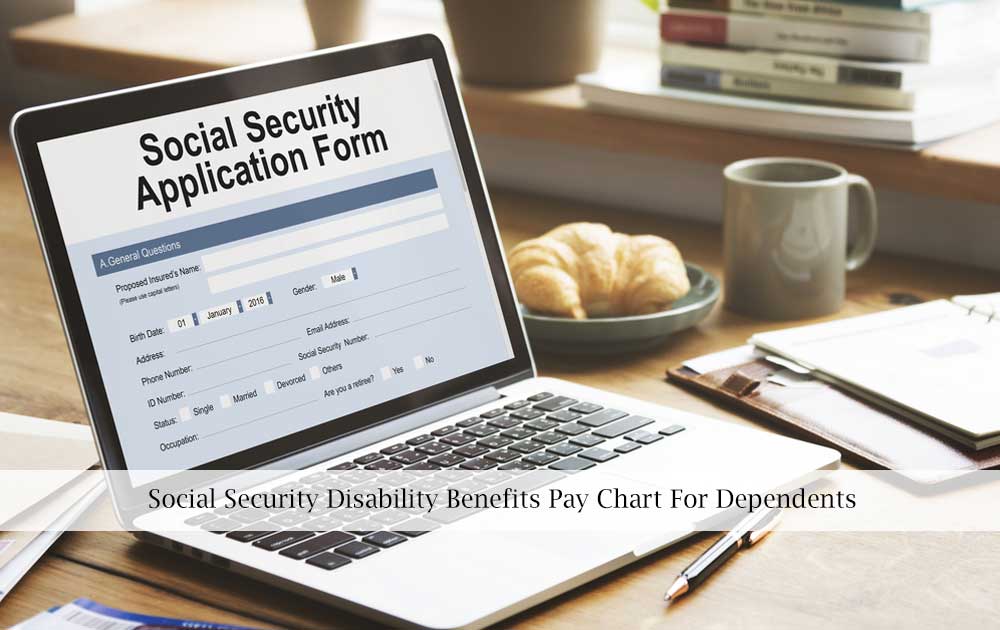The Social Security Disability (SSD or SSDI) maximum monthly income caps for SSD benefits recipients change every year. The Clauson Law Firm specializes in helping people who apply for and receive SSD and SSI benefits, and we want you to be fully informed about all the upcoming SSDI changes for 2022.
2022 Maximum Monthly Income Changes ($1,350, up from $1,310)
The 2021 income limit for those receiving SSDI benefits was $1,310 per month. That is what the Social Security Administration (SSA) set as the income level above which iS considered a worker “not disabled.” The exceptions to that rule are explained below in this blog article. That level of monthly income was the maximum amount of countable income a recipient could receive unless they were blind. Blind applicants are permitted to earn more due to their special disability; their income cap is $2,190 per month in 2021.
The new year brings an entirely new set of limits because the income caps and benefit amounts need to be adjusted to keep up with the rate of inflation seen during the previous year.

The new 2022 SSD monthly income limit is $1,350 for benefit recipients with vision and $2,260 for blind SSD recipients.
- 2021 Maximum Allowable Earned Income Drawing SSD Benefits = $1,310 per month.
- The blind SSD benefits recipients’ earning limit is $2,190 per month.
- 2022 Maximum Allowable Earned Income Drawing SSD Benefits = $1,350 per month.
- The blind SSD benefits recipients’ earning limit will be $2,260 per month.
What If You Make More Than the 2022 Maximum Income Limit?
The SSA imposes limits on the amount benefit recipients can earn each month because they use the physically or mentally impaired person’s ability to earn income as the defining factor to determine if their impairment qualifies as a “disability” for purposes of collecting SSD benefits.
The SSD program exists to provide financial support to people who paid FICA taxes into the Social Security Disability fund through many years of payroll deductions and self-employment taxes. The SSD benefit is intended to be a substitute for your lost wages or salary during your period of disability. But SSD benefits are reserved for disabled former workers whose injury or illness prevents them from earning an income to support themselves and their families.
The most experienced SSDI/SSD lawyers are experts in all the 2022 changes to SSD benefit levels, monthly benefit payments, and other details you need to know as an SSD applicant or recipient. Every SSD and SSI lawyer at Clauson Law devotes their professional life to helping disabled North Carolinians get the full benefit they deserve.
The SSA rules and regulations set the level of income the government believes is enough to be “Substantial Gainful Activity” (SGA). This Substantial Gainful Activity threshold is the SSD program’s monthly income cap. Only those who are not able to perform Substantial Gainful Activities are eligible to receive SSD benefits, even if their physical or mental impairments are genuine.
In a brief statement, a person qualifies to receive SSD benefits only if:
- they paid enough into the system to earn the minimum work credits required,
- they have a medically determinable physical or mental impairment,
- their impaired condition renders them unable to earn more than $1,350 per month (if sighted),
- and they have been or are expected to be unable to earn more than $1,350 per month for at least 12 months, or their impairment is expected to result in their death.
If you earn more than the monthly income cap, then you are not recognized as disabled by SSA, and you are not eligible to receive Social Security Disability benefits.
What If You Exceed the SSD Monthly Income Limit Temporarily?
Receiving Social Security Disability benefits may suggest that someone is too disabled to do any work. That’s simply not true. The measure to continue to be eligible for SSD benefits is whether a person can earn more than the monthly SSD income cap. Many worthy, qualified, eligible disabled SSD beneficiaries work or earn income part-time, but their income remains beneath the monthly maximum limit.
But what do you do if your part-time job is in a retail store where you earn more during the holiday shopping season?
Do you lose your SSD benefits if you exceed the monthly income cap for two or three consecutive months? During the month or more in which you earn more income than the SSD regulations allow to remain eligible for SSD benefits, you do normally lose the payment for those months. If a retail worker earned more than the income limit in November, December, and January, but then either got laid off or had their hours reduced to a level bringing their income under the SSD income cap, then they would immediately regain SSD benefit eligibility.
Income Reporting Obligations
The Social Security Disability benefits program requires that every person receiving SSD benefits report their income every month. Some people are tempted to misstate or hide a bit of income to keep their reported income under the SSD income limit. That’s not a good idea for two reasons.
First, knowingly providing false or inaccurate information to a government agency to get financial support for which the person isn’t eligible can become a criminal offense. The SSA does not investigate or prosecute every person who mistakenly omits a source of income once or twice for small sums. But anyone who persistently deceives the SSA to obtain benefits they don’t qualify for could find themselves facing federal indictments for Social Security wire fraud or mail fraud or other serious felonies.
Second, if the SSA detects or discovers that you received SSD benefits during a month that you were ineligible because you misstated your income, your benefit payment will be suspended for one month and you will need to repay the benefits you were overpaid. A second offense will bring a two-month suspension, and a third or subsequent incident will result in a three-month benefit suspension.
If an SSD benefit recipient fails or refuses to provide income information without good cause, then benefits will be suspended until the income is reported. If after 12 months of suspension the income date is not submitted, then the SSA may terminate the SSD benefits.
The Good News About Reporting Income
The upside of reporting your monthly income is that timely reporting will immediately entitle you to resume your SSD benefits if you temporarily exceeded the income limit. There is no need to reapply and no need to await approval to resume benefits. Your impairment remains active if only your income topped the limit temporarily.
How to Make More Than the Income Cap and Still Get SSD Benefits?
The TRIAL WORK PERIOD Program (TWP)
Once the Social Security Administration realized that suspending the SSD benefits of a recipient who succeeded in earning more than the income cap in one month discouraged SSD beneficiaries from trying to work, the SSA needed to solve this dilemma. The SSA wanted to encourage SSD recipients to attempt a return to work, if they thought they were up to it. How else would a disabled person know what they were capable of achieving as time passed and their impaired condition improved?
The Trial Work Period (TWP) program enables SSD recipients to “try” to resume working without fear of losing their monthly SSD benefit. Under the TWP plan, a disabled SSD recipient who thinks they may be able to return to work is free to try and continue to get their monthly SSD payments.
There are rules and limits to the TWP program, but the arrangement allows you to earn an “unlimited amount of monthly income” for a total of nine months. The nine months do not have to be consecutive. They can be spread out over a five-year period.
Which Months Count as Trial Work Period (TWP) Months?
The Trial Work Period program can run for any nine months in a five-year period. So, which months count as TWP months? While you can earn an unlimited amount of income in each of the nine months of your TWP, any month in which you earn more than $907 is counted as one TWP month. In 2022, the TWP monthly trigger amount will be $970.
What Happens When Your Nine-Month Trial Work Period (TWP) Ends?
If you participate in the Trial Work Period Program (TWP), at some point you will use up your nine months of unlimited income while still receiving your full SSDI benefits. What then?
The Extended Period of Eligibility — When you exhaust your nine TWP months, the SSA wants to give you the incentive to continue working if you can. The Extended Period of Eligibility (EPE) is a 36-month period in which you have an income “safety net.”
Each month, the SSA checks your reported income to see if you exceeded the monthly income cap that is “substantial gainful activity” (SGA). If you do exceed the SGA level, you will continue to receive your full SSD benefit during a 3-month grace period. After that, your SSD benefit payment will be suspended for any month your income is above the SGA.
But, if during the 36-month safety net period your earnings again fall below the SGA level, your SSD benefit payments will resume for each such month.
What is the maximum allowable earned income drawing SSD benefits in 2022?
The SSD monthly income limit is $1,350 for benefit recipients with vision and $2,260 for blind recipients.
What is the Trial Work Period (TWP) monthly trigger amount in 2022?
While you can earn an unlimited amount of income in each of the nine months of your TWP, the monthly trigger amount in 2022 is $970.


